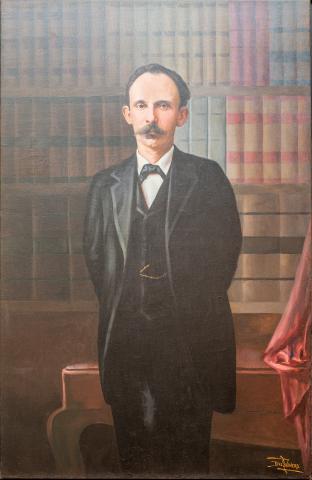
José Martí (1853–1895)
The poet and thinker José Martí grew up in Cuba during a time when enslaved labor was critical to its plantation-based economy and when civil rights were strictly limited by the Spanish colonial government. Martí was first imprisoned as a teenager for publishing La patria libre (The free homeland), a newspaper supporting the Ten Years’ War (1868–78). Subsequently, he advanced his anticolonial ideals through extensive writing, becoming a towering Latin American intellectual.
Martí spent his last fifteen years exiled in New York City, where he established the Partido Revolucionario Cubano (Cuban Revolutionary Party) in 1892. Martí called for a final “Necessary War” against Spain to liberate Cuba and combat the legacy of slavery: racial inequality. He aspired to create “a republic for all.” Martí died in battle in May 1895 during Cuba’s third War of Independence (1895–98).
Miguel Díaz Salinero created multiple posthumous paintings of the “Apostle of Cuban independence,” helping cement his likeness in Cuban art and history.
Audio Transcription: José Martí Pérez is one of the most relevant Latin American figures of the 19th century because of his literary production, which establishes him as an important precursor of modernism, but also for his independentist political thought. This portrait follows the academic cannon attempting to achieve fidelity to the historic image by way of physical characteristics that are very specific, like the narrow, set-back jaw, which accentuated Martí’s forehead and his deep stare. This painting is inspired by a photograph of Martí taken in Jamaica in 1892 by Juan Bautista Valdez. But in the painting the artist moves this full-body, standing figure from an exterior setting in Jamaica to an interior space, where he recreates José Martí’s New York office, placing him in front of his bookshelves and desk, which were so well known to Cubans. In this way, this portrait pays homage to the only portrait of the apostle painted from life, which was done by the painter Herman Norman.